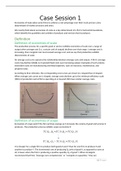Essay
Essay visies op de stad; stedelijke ontwikkeling in het buitenland
- Instelling
- Radboud Universiteit Nijmegen (RU)
Deze opdracht telt voor 60% van het eindcijfer op het vak 'visies op de stad'. De opdracht was een stedelijke ontwikkeling in het buitenland omschrijven. Ik koos voor duurzame mobiliteit in Straatsburg. Hiervoor kreeg ik een 8,5.
[Meer zien]













